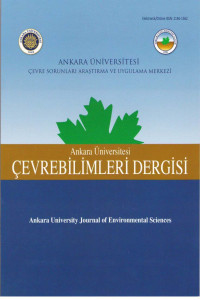Türkiye’de Afet Yönetimi Bağlamında Kritik Altyapı Kavramı
Kritik altyapılar, kritik altyapıların korunması, kritik altyapı sektörleri
The Concept of Critical Infrastructure in the Context of Disaster Management in Turkey
Critical infrastructures, Protecting of critical infrastructures, Critical infrastructure sectors,
___
- AFAD. 2014. Kritik Altyapıların Korunması Yol Haritası Belgesi (2014-2023), Ankara, s.4
- AFAD. 2022. İzmir Aliağa Bölgesinde Enerji Sektörü Özelinde Kritik Altyapılara İklim Değişikliğinin Etkisi Projesi Sonuç Raporu
- AFAD, TÜBİTAK-BİLGEM 2016. Ulusal Kritik Altyapı, Varlık ve Tesisleri Belirleme, Risk Değerlendirme ve Önceliklendirme Projesi Sonuç Raporu
- CISA. Critical Infrastructure Sectors. https://www.cisa.gov/topics/critical-infrastructure-security-and-resilience/critical-infrastructure-sectors, (Erişim Tarihi 05.04.2023)
- Commission of The European Communities. 2005. Green Paper On A European Programme For Crıtıcal Infrastructure Protection, Brussels, 17.11.2005 COM(2005) 576 final, s.20-24.
- Critical Infrastructure Centre. 2023. What is the Critical Infrastructure Centre?, https://www.homeaffairs.gov.au/nat-security/files/cic-factsheet-what-is-critical-infrastructure-centre.pdf, (Erişim Tarihi:06.04.2023)
- European Union (EU), 2008. COUNCIL DIRECTIVE 2008/114/EC of 8 December 2008 on the identification and designation of European critical infrastructures and the assessment of the need to improve their protection, Official Journal of the European Union, s.75-82
- Germany Federal Office of Civil Protection and Disaster Relief (BBK), Federal Office of Information Security (BSI), Critical Infrastructure Protection Internet Platform; Critical Infrastructures, https://www.bbk.bund.de/DE/Themen/Kritische-Infrastrukturen/kritische-infrastrukturen_node.html, (Erişim Tarihi:06.04.2023)
- Moteff, John D. 2015. Critical Infrastructures: Background, Policy, and Implementation, Congressional Research Service, s.3
- National Protective Security Authority, 2023. Critical National Infrastructure, https://www.npsa.gov.uk/critical-national-infrastructure-0, (Erişim Tarihi:06.04.2023)
- NISC. 2007. National Information Security Centre. 2007. Japanese Government’s Effort to Address Information Security Issues, https://www.nisc.go.jp/eng/pdf/overview_eng.pdf, (Erişim Tarihi: 10.04.2023)
- OECD. 2007. Development of Policies for Protection of Critical Information Infrastructures, OECD Digital Economy Papers No. 130, Ministerial Background Report, Seoul, Korea, s.9
- OECD. 2022. Recommendation of the Council on OECD Legal Instruments the Protection of Critical Information Infrastructures, https://legalinstruments.oecd.org/public/doc/121/121.en.pdf, (Erişim Tarihi: 06.04.2023)
- T.C.Cumhurbaşkanlığı Hazine ve Maliye Bakanlığı (2020-2022), Yeni Ekonomi Programı, https://ms.hmb.gov.tr/uploads/2019/10/Yep-Eyl%C3%BCl-1.pdf, (Erişim Tarihi: 27.05.2023)
- T.C.Cumhurbaşkanlığı Strateji ve Bütçe Başkanlığı, (SBB). 2019. 11. Kalkınma Planı, Ankara, s.171 UAB, 2020. Ulusal Siber Güvenlik Stratejisi ve Eylem Planı (2020-2023), http://www.sp.gov.tr/upload/xSPTemelBelge/files/HwolM+ulusal-siber-guvenlik-stratejisi-ep-2020-2023.pdf, (Erişim Tarihi:25.04.2023)
- UN. 2015. Sendai Framework for Disaster Risk Reduction 2015 – 2030, https://www.preventionweb.net/files/43291_sendaiframeworkfordrren.pdf, (Erişim Tarihi, 05.04.2023)
- UNDRR. 2015. Proposed Updated Terminology on Disaster Risk Reduction: A Technical Review, https://www.preventionweb.net/files/45462_backgoundpaperonterminologyaugust20.pdf, (Erişim Tarihi, 05.04.2023)
- Yayın Aralığı: Yılda 2 Sayı
- Başlangıç: 2009
- Yayıncı: Ankara Üniversitesi
Türkiye Afet Risklerinin Azaltılması Platformuna Genel Bakış
Betül KURADA, Evren TANRIVERDİ, Mehmet Fatih ŞEN, Esen DEMİRKOL KILIÇ, Derya YALÇIN
Depremler Sonrası Antakya Kentsel Kültürel Mirası Hakkında Değerlendirme
Funda VARNACI UZUN, Mehmet SOMUNCU
Ilgaz Dağı Milli Parkında Korunan Alan Turizm İlişkisinin Sürdürülebilirliği Üzerine Bir Araştırma
Türkiye’de Afet Yönetimi Bağlamında Kritik Altyapı Kavramı
Evren TANRIVERDİ, Betül KURADA, Mehmet Fatih ŞEN, Esen DEMİRKOL KILIÇ
